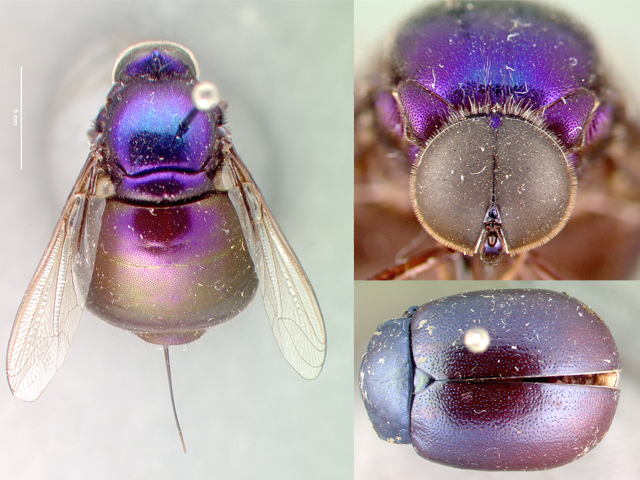 Glass klettii: Fotografie v dubnu Nobile, POUZDRO
Glass klettii: Fotografie v dubnu Nobile, POUZDRO
Z velké části mouchy nejsou hmyz jsem si příliš nadšený. Nicméně, tajemný rodina Acroceridae jsou výjimkou. Začnu sdílet některé zajímavé rody čas od času – morfologie rodiny je úžasně rozmanitá. Většinu svých dní trávím v muzeu inventarizací naší rozsáhlé sbírky 16,000 Acorceridy (alias mušky malohlavé). To nemusí znít příliš působivě, když to porovnáte s jinými početnějšími rodinami (a bledne ve srovnání s koncem 17,500,000 jiný exempláře, které máme v muzeu); ale ukazuje se, že představuje mnoho, ne-li většina, z Všechno známé exempláře pro celou rodinu. I když pravděpodobně existují velká shromáždění těchto much v jiných institucích, Kalifornská akademie věd si může tento rekord snadno nárokovat od doby, kdy obdržela sbírku Dr. Evert I. válec (který občas přijde do práce z muzea).
Ukázalo se, že akroceridy jsou poměrně obtížně studovatelnou skupinou, protože jsou v přírodě vzácné, jejich parazitoidní biologie, a jak těžké je chytit na křídle. Jejich velký hrudník je plný svalů, které létají vzduchem – takže pokud je nechytíte na květině, budete toužit po pasti na Malaise. Ev mi vyprávěl jeden příběh o tom, jak se je naučil chytat na křídle v Kostarice. Stojíte po větru od kolegy v poli – jakmile někdo něco zaslechne, divoce se houpeš a doufáš, že chytíš mouchu náhodou… funguje to jednou za čas. Tyto mouchy jsou také jedinými známými endoparazity dospělých pavouků (může existovat záznam o tachinidovi…). Výše uvedený rod, NeoLasia, je parazitem sklípkanů Theraphosid (něco jako Aphonopelma). Jako larva se moucha propracuje po pavoučích nohách a zavrtá se do břicha, kde se poté usadí vedle plicní knihy a vystrčí malý dýchací otvor.. Pak trpělivě čeká, až se pavouk blíží dospělosti. Se samičkami sklípkanů, moucha mohla být nečinná po celá desetiletí. Nakonec se stane něco podobného jako ve filmu Vetřelci a larvy se živí vnitřními orgány pavouka a pak se vynoří, aby se zakuklily.. Ale zjistit, zda pavouk má nebo nemá parazita, je nemožné bez pitvy – takže k získání záznamů o hostiteli je třeba udržovat velké sbírky živých pavouků. Biologie parazitoidů je prostě skvělá.
Výše uvedený exemplář (Glass klettii nový, bezejmený, druh) byl shromážděn v 1977 od Schlinger poblíž města Alamos, Mexiko – na květiny s pravděpodobným mimickým modelem, brouk Chrysomelidae (broučí lidé, jakékoli nápady mimo rodinu?).

Very interesting! Out of curiosity, because you mention large collections of live spiders, has any researcher reached out to the hobby tarantula keepers in a quest for specimens? While I have never seen something as spectacular as the above emerge from a wild caught tarantula, I have heard from a few people who ended up with “strange” flies in the past…
Reaching out to them for actual tarantulas has lead to quite a few specimens for Brent Hendrixson on his revision of the genus Aphonopelma, at least for the USA native species. There also are frequently imports of various species brought in from Central and South America, which is not a practice I like or am comfortable with…but it might lead to at least a few specimens given the numbers involved. Just a thought.
I think the answer is somewhat. I’ve reached out on message boards and even recently gave a short talk to the SF Bay Area Tarantula Society. The problem comes down to peoples immediate response when they see a giant grub crawling out of their spider – they reach in and grab their prize specimen and in the process damage the larvae or pupae of the emerging fly. As it turns out these flies are pretty sensitive before pupating and while I’ve seen lots of maggot images, never seen a fly reared by a hobbyist. I think the biggest hurdle is that people only discover what they are after they have had a spider die – and chances are it’ll be years before another one of their wild caught immature spiders are parasitized!
That makes a lot of sense, I guess it didnt really occur to me that for most people having a parasite emerge from one of their captives is a bad thing…that sort of thing would make my day. 🙂
Especially if that spider cost you a few hundred dollars!!
I wonder if that fly sees very well. 🙂
First impression of the beetle is a species of Chrysolina (subfamily Chrysomelinae), but my knowledge of Neotropical chrysos is limited.
Thanks for the genus ballpark – I’ll have to dig through our collections here to see if I can’t narrow it down more.
Did you mean that these acrocerid flies are the only known dipteran endoparasites of adult spiders? There are certainly spider-parasitic nematodes, and mantidfly larvae can crawl into the book lungs of their spider hosts and feed on hemolymph while hitching a ride to the egg deposition site.
http://en.wikipedia.org/wiki/Mantispidae
And here’s a cool post about a mantidfly larva on a spider, preserved in amber!
http://blogs.discovermagazine.com/notrocketscience/2011/03/28/spider-boarding-insect-preserved-in-amber/
(Tak určitě, that one’s on the outside of the spider, but the post also has more info on other tactics.)
Thank you for pointing that out! You’re correct of course, when I was thinking “no other endoparasitoids” I totally neglected non-insects such as nematodes. I should have recalled how tricky it can be to control nematode infestations in captive bread spiders!
I also did not know that about mantidflies. Actually I should catch up on the literature, there may be other diptera or hymenoptera parasitoids more recently known. Very cool, thanks for the link.
Augh augh augh and here’s a picture of a huuuuuge nematode coming out of a spider! It’s even one of the behavior-modifying parasites — it induces its host to seek out water before dying, so the nematode can complete its life cycle. (Like the horsehair worm in crickets!)
http://www.abc.net.au/science/k2/stn/spider.htm